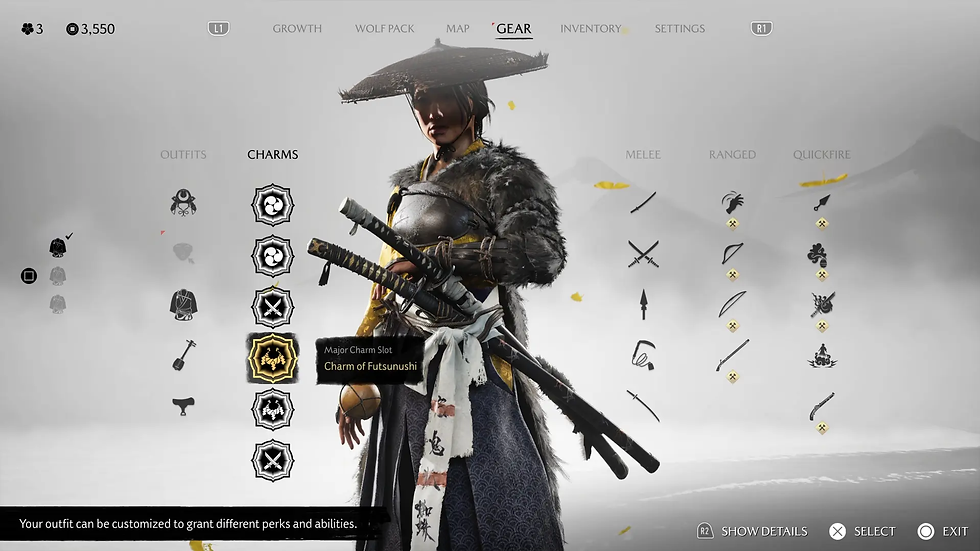Through Mist and Memory: The Ghost of Yotei Review
- Aaron Greenfield

- Oct 8
- 3 min read
Ghost of Yotei is a masterclass in sequel design — a game that doesn’t just follow in the footsteps of its predecessor, but redefines the path entirely. It’s a visual and mechanical triumph, blending cinematic beauty with fluid gameplay and emotionally resonant storytelling. While not without its limitations, it stands as one of the most compelling open-world action titles of the year.

Visuals and Worldbuilding
The game’s environments are nothing short of breathtaking. From the frostbitten ridges of Mount Yotei to the mist-laced forests and windswept coastal villages, every location feels handcrafted and alive. The lighting engine, particle effects, and weather transitions create a dynamic canvas that rewards exploration. The absence of a traditional HUD during traversal enhances immersion, allowing players to engage with the world on its own terms.
Photo Mode returns with expanded features, enabling players to manipulate wind, time, and ambient effects — a nod to the game’s cinematic aspirations. It’s not just a game world; it’s a living diorama.

Combat and Movement
Combat has undergone a subtle but meaningful evolution. The stance system is gone, replaced by a weapon-based tactical approach that emphasizes timing, precision, and adaptability. Every encounter feels like a duel — stylish, brutal, and deeply satisfying. The animation work is exceptional, with fluid transitions between attacks, counters, and evasions that make combat feel like choreography.
Traversal is equally refined. Sprinting, climbing, and dodging are seamlessly integrated, giving players a sense of true freedom. Whether scaling cliffs or weaving through bamboo groves, movement feels intuitive and empowering.

Narrative and Emotional Depth
The story follows Atsu, a mercenary haunted by loss and driven by vengeance. While the revenge arc is familiar, Ghost of Yotei elevates it through strong writing, layered flashbacks, and symbolic motifs — most notably the burning of the ginkgo tree, which serves as a thematic anchor. The narrative explores grief, identity, and redemption with a maturity that sets it apart from genre peers.
NPC interaction is limited, but those you can engage with are well-realized, offering meaningful dialogue and emotional weight. The main cast is particularly strong, with character designs that reflect cultural authenticity and narrative depth.
Exploration and Side Content
The world is dense with activities — hidden shrines, collectibles, side quests, and secret areas that reward curiosity. While some side missions lean into familiar fetch-quest territory, others offer rich lore and character development. The map is more compact than its predecessor, reducing traversal fatigue and increasing the density of meaningful content.
Cultural Detail and Controversy
Set in 1600s Hokkaido, the game reflects deep historical research. Architecture, wildlife, and cultural practices are rendered with care. However, one mechanic — petting Ezo red foxes — sparked controversy due to real-world health concerns. While accurate, it raised questions about responsible representation, especially among Japanese players.
Performance and Reception
Despite some negative press, Ghost of Yotei launched to critical acclaim, with a 4.88/5 rating from over 13,000 players on the PlayStation Store. Critics praised its polish, emotional storytelling, and visual fidelity. While it doesn’t radically innovate, it refines and elevates — offering a tighter, more resonant experience than its predecessor.

Final Verdict
Ghost of Yotei is a stunning sequel that balances beauty, brutality, and emotional depth. It honors the legacy of Ghost of Tsushima while carving its own path through snow, sorrow, and steel. With cinematic visuals, fluid combat, and a deeply personal story, it’s a must-play for fans of samurai fiction and open-world adventures.
Pros
Exceptional visual design and cinematography
Deep, emotionally resonant story
Satisfying and stylish combat
Rich open world with meaningful exploration
Cons
Limited NPC interaction
Some repetitive side activities
Combat loop may fatigue over long sessions
Rating: 9.2/10 — A visually poetic and emotionally grounded triumph.




Comments